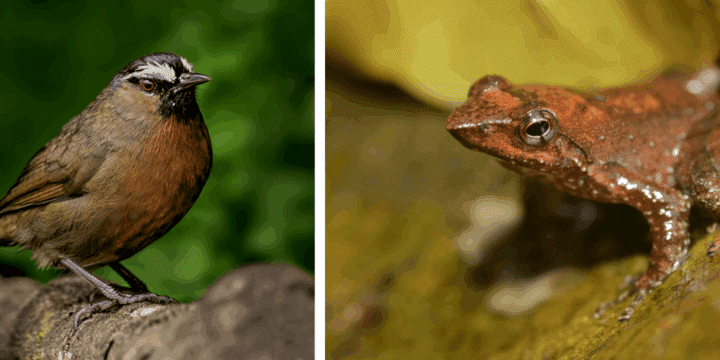Welcome to the Conservation Evidence blog
Welcome to the new blog from Conservation Evidence and the Conservation Evidence Journal! We hope to use this blog as a platform to showcase not only what we do at Conservation Evidence, but also to showcase evidence-based projects from partners, collaborators and others in the conservation field. Do get in touch if you would like us to feature your work.
Today in our first post, we want to introduce (or re-introduce) you to the Conservation Evidence project.
What is the Conservation Evidence project?
Conservation Evidence (CE) is a free, authoritative information resource designed to support decisions about how to maintain and restore global biodiversity. CE does this by providing summaries of evidence from the documented literature about the effects of conservation actions such as methods of habitat or species management. So if you’re looking for information on how to increase amphibian populations, which road crossing structure is best for bats, or what information is available for conservation education programmes, then CE could be the resource for you!
Why use CE?
Evidence-based decision making is the foundation of medical practice and is increasingly recognised as being important in other fields such as education and also conservation.
Not using the documented evidence in decisions has been shown to lead to detrimental actions being undertaken that waste time, money, and other resources all of which are scarce in conservation. In order to meet many critical conservation and biodiversity targets we need to avoid this. Conservation Evidence should be used alongside other important information to further help you make the most informed decision possible.
What information is available?
Evidence of the effectiveness of actions is collated into synopses based upon species groups, habitats, or particular conservation issues. Since its inception, the CE database has published 17 synopses, covering 2,399 actions and 6,913 studies. The aim is to cover actions for all habitats and taxonomic groups by 2025. You can see which synopses are currently available here, and which ones are upcoming here.

Once this information has been collated for a subject, we invite a panel of experts to rate the effectiveness of actions based on the summarised evidence (for more details see here). Each year we publish the evidence in What Works in Conservation, which you can download here for free. This allows users to see at a glance whether an action is likely to be beneficial or not, of course it’s always important to check the details!

You can also help to fill gaps in the evidence base by publishing new evidence in our online, open access, peer-reviewed Conservation Evidence Journal. The journal publishes results from research and projects investigating the effectiveness of conservation actions. Our next post will feature more information about the journal and how to get your work published.
How much evidence does CE have?
So far we have searched over 330 English-language journals, including 30 important conservation journals (such as Conservation Biology, Biological Conservation, Ecology, Journal of Applied Ecology, Oryx) and systematic reviews published by the Collaboration for Environmental Evidence which we search regularly. We have also searched over 300 non-English language journals for relevant studies. In addition, we search ‘grey literature’ such as report series produced by conservation or governmental organisations.
Is that it?
No! In fact, the team at Conservation Evidence are not only working on collating the documented evidence, but also looking at ways to make it more easily usable, these include:
Metadataset
Metadataset aims to tackle one of the major issues facing evidence synthesis: how to make global evidence relevant at local scales. Metadataset addresses this problem by enabling users to filter and weigh the global evidence based on their local needs.
Evidence Champions
Evidence Champions is the partnership programme of Conservation Evidence. With these partners we co-design and produce the tools and guidance needed to use evidence, in order to make scientific evidence use routine and increase the effectiveness of conservation actions. You can find out more about the programme here.
Decision support tools
We are keen to work more with practitioners on co-designing decision support tools, such as the one available here (www.evidence2decisiontool.com). This guides users through making an evidence-based decision on which actions should be implemented to solve a conservation management problem. The tool helps users approach the daunting task of incorporating scientific evidence, local knowledge, costs, and information on the acceptability and feasibility and produces a downloadable document that transparently records the reasons and logic behind the decision. This could be useful to help show why decisions have been made and ensure due diligence is undertaken before making management decisions. We’re hoping we can build partnerships with different groups of practitioners to embed these principles of evidence-based conservation into their ways of working and decision processes. If you’re interested in working with us to do this, please get in touch – we’d love to have your input to help us co-design better decision support tools in the future.
What don’t we do at CE?
We cannot make recommendations or offer guidance for a particular site or project. This is because it is difficult to give evidence-based conservation advice that is appropriate for every context. Instead, we provide evidence and an assessment of that evidence which should be interpreted by conservationists who understand their own site and national or regional situation.
We only focus on evidence of the effects of actions, not the impacts of threats or the status of species for example and we do not include other forms of evidence such as expert knowledge or case studies. Some other projects and platforms do focus on these topics and can be found in the list below. If you see one we’ve missed, let us know and we will add it to the list.
The PANORAMA web platform from IUCN includes more than 500 case studies from around the world as well as a range of mechanisms and tools, including peer exchange events and communication products.
Applied Ecology Resources (AER) curates a wide range of information sources such as open access journal articles, research summaries and other grey literature. The full searchable database will be launching in early 2021.
The Collaboration for Environmental Evidence promotes and delivers evidence syntheses on issues of greatest concern to environmental policy and practice as a public service. Syntheses take the form of systematic reviews and (evidence) maps providing rigorous and transparent methodology to assess the impacts of human activity and effectiveness of policy and management interventions.
The CABI Invasive Species Compendium provides detailed coverage of invasive species threatening livelihoods and the environment worldwide.
The Nature-Based Solutions Initiative Evidence Platform seeks to enhance understanding of the potential of Nature-Based Solutions to address global challenges and increase their sustainable implementation worldwide. It provides an interactive map linking nature-based solutions to climate change adaptation outcomes based on a systematic review of the peer-reviewed literature.
The Alliance for Conservation Evidence and Sustainability (ACES) is an NGO-led collaboration focused on generating, synthesizing, and using evidence for community-based conservation (CBC).



